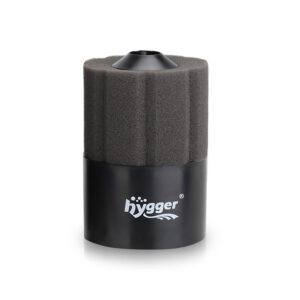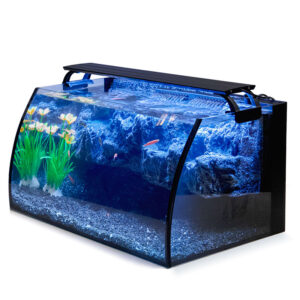Bettas are one kind of colorful fish, which can be found in shallow Marshes of water, ponds, or slow-moving streams. However, to help bettas live comfortably and longer in a fish tank, it is crucial to keep them in a suitable tank size for betta fish and do proper maintenance. In this article, let’s learn more about that.
Content Table
Can a betta live in an 8-gallon tank?
Perhaps you have heard that bettas can live in a 1-gallon fish tank. Nevertheless, your appealing bettas may not feel comfortable and even suffer from death after a short time. Consequently, this segment will give you ideas about feasible tank sizes.
| Fish | Minimum tank sizes |
| Veiltail Betta | 4 gallons |
| Crowntail Betta | 5 gallons |
| Halfmoon Betta | 4 gallons |
| Blue Betta Fish | 5 gallons |
| Mustard Betta | 2.5 gallon |
| Butterfly Betta | 5 gallons |
| Koi Betta | 5 gallons |
What’s the best tank size for betta fish? In short, most bettas can be kept in an 8 gallon tank. Meanwhile, a betta fish tank is a great option for bettas because it is a tank with light, a filter, and a 3D background. The unique convex arc curve shape makes the new view for bettas.

How long do betta fish live in an 8-gallon tank?
How long do betta fish live in the tank? Generally, bettas can live up to 2–5 years on average. Nevertheless, factors, including tank size, water conditions, daily maintenance, tank mates, diet, and disease, will affect the bettas’ lifespan. Besides that, it is recommended not to keep bettas with other fish. Or it will cause fighting, injury, and even death. Because bettas are aggressive, especially for other fish species. Thus, keeping bettas in a fish tank with their species is a better option to make them live longer.
How often should you change betta fish water?
Generally, a small fish tank means a large water change. Since a small tank takes less time to accumulate harmful substances, ammonia, nitrite, and nitrate for instance, next, we will discuss the frequency, volume, and steps of water change.
Frequency and volume of water change
Usually, it is feasible to change 20-30 percent of the water once a week. Nonetheless, it varies from different fish tanks. Tank size, aquarium filter, and tank mates will have an impact on the frequency and quantity. Here are some recommendations:
| Betta fish tank | Water changer frequency | Water change volume |
| Less than 5 gallons | Once/twice per week | 40-50 percent |
| More than 5 gallons | Once a week | 20-30 percent |
| Tanks with good filtration | Once a week | 15 percent |
| Tank without a filter | Once a week | 50 percent |

How to change betta fish water
1. Aquarium supplies for the water change
When are you doing a water change, some aquarium supplies may be necessary.
- Aquarium water test kit: It can test the water parameters of new water, including pH level, hardness, ammonia, nitrates, nitrites, total chlorine, carbonate root, and total alkalinity.
- Water conditioning solution: It helps to remove chlorine and other harmful chemicals in the water.
- Thermometer: Check the water temp of new water and old water, then keep their temp the same.
- Fish tank vacuum: It plays a role in water change and tank cleaning.
- Algae scraper: A fish tank cleaner – magnetic algae scraper helps to get rid of various algae without wetting your hands.
2. Change the water completely
- Step 1: Prepare two clean buckets with water. One for new water, while another for stocking fish temporarily. You should keep in mind maintaining great water parameters.
- Step 2: Turn off all aquarium equipment.
- Step 3: Remove the bettas to one bucket with a fish net. And take out the fish tank heater and other decorations.
- Step 4: Pour out the water in the fish tank. A gravel vacuum can help you a lot.
- Step 5: Clean the fish tank, substrate, and decorations. A soft sponge, algae scraper, and clean water are enough. Please attention, you should not clean your tank or decorations with soap or detergent. Or it will have a bad impact on your fish.
- Step 6: Set up your tank. Put and smooth the substrate. Then place the decorations, such as rocks, wood, and aquatic plants.
- Step 7: Refill the tank with new water, slowly, through a sponge is recommended.
- Step 8: Move your fish back to the tank.
- Step 9: Place the aquarium supplies back in the tank, including the aquarium heater, filter, and air pump. Next, turn on and set suitable parameters.

3. Change the water partially
- Step one: You should prepare new water in advance. And keep the same water temp as the old water.
- Step two: turn off the aquarium heater, light, filter, and other equipment.
- Step three: Clean the fish tank glass with an algae scraper or a flat sponge.
- Step four: Remove the water from your fish tank, you can ask vacuum gravel for help.
- Step five: Refill the fish tank with new water. One tip here, you can put an aquarium sponge above the substrate, and then slowly pour the new water into the tank.
Help your betta live longer
Aside from all mentioned above, in this segment, let’s learn some methods to make your cute and attractive bettas live longer.
Keep bettas in a large tank
Exactly, a 1-gallon fish tank is too small for adult bettas. On the contrary, keeping betta fish in a 5-gallon aquarium is a better choice. Too small tanks pose threats to bettas, such as water temperature fluctuation and bad water quality. Or the fish may even be depressed and bored.
Provide a natural habitat
A natural habitat makes your betta fish comfortable and enjoyable, then they can grow better. Bettas are fond of hiding places where they can avoid attack and rest. Therefore, you can provide sufficient hiding places with aquatic plants, rocks, or other aquarium decorations. Here are some best plants for a betta fish tank, anacharis, wisteria, and hornwort for example. Besides that, since betta fish love to swim around the fish tank, you should also leave enough room for them to explore.

Maintain great water parameters
Keeping clean fish tanks and good water quality is also crucial. To begin, regular water change is needed. Moreover, adding a sponge filter will help to keep great and stable water quality. In addition, it is necessary to place an aquarium heater to keep a stable water temperature.
- Water temp: 75-80℉
- pH level: 6.5-8
- Ammonia: 0 ppm
- Nitrite: 0 ppm
- Nitrate: no more than 20 ppm
Suitable diet for bettas
Bettas are carnivores. Betta pellets, betta flakes, bloodworms, brine shrimp, daphnia, and other high-protein foods can be great options. Do not forget to avoid overfeeding. Twice a day is feasible, and make sure to finish eating in about 2 minutes. However, you can just feed brine shrimp or bloodworms once or twice each week. On the other hand, you should avoid bread or the roots of plants. For more additional information about bettas’ diet, the article What Do Betta Fish Eat – Brine Shrimp for Bettas will give you ideas.
Keep bettas with ideal tank mates
Nerite snails, otocinclus catfish, and kuhli loaches are excellent tank mates for bettas fish. Nonetheless, it is better to keep bettas in their species. But do not keep two male bettas together, or they will become extremely aggressive, and then cause attack and injury. For more about bettas’ tank mates, please visit What Fish Can Go with a Betta in a Fish Tank.
Relative topics
In summary, properly keeping bettas helps them live longer. Also, it would help if you kept your bettas happy. The ways to keep them happy, you can read What Is a Good Way to Keep Betta Fish Happy.
That is all for today. If you have any interesting things about bettas or good ideas about betta fish keeping, welcome to leave messages in the comment! We are glad to receive your sharing. Finally, thanks for your reading!


Leave a comment